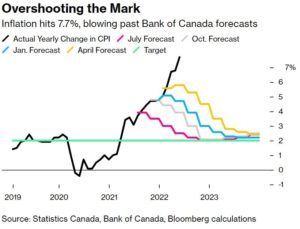| Canada’s consumer price index increased 7.7% in May from a year earlier, up from 6.8% in April, the fastest inflation pace since January 1983. The release confirms that the Bank of Canada is staring down the most dangerous burst of Inflation since it started targeting the consumer price index in the early 1990s.
Excluding gasoline, the CPI rose 6.3% year over year in May, after a 5.8% increase in April. Price pressures continued to be broad-based, pinching the pocketbooks of Canadians and, in some cases affecting their ability to meet day-to-day expenses.
The acceleration in May was mainly due to higher gasoline prices, which rose 12.0% compared with April 2022 (-0.7%). Higher service prices, such as hotels and restaurants, also contributed to the increase. Food prices and shelter costs remained elevated in May as price growth was unchanged year-over-year.
Monthly, the CPI rose 1.4% in May, following a 0.6% increase in April. On a seasonally adjusted monthly basis, the CPI was up 1.1%, the fastest pace since the introduction of the series in 1992.
Wage data from the Labour Force Survey found that average hourly wages rose 3.9% year over year in May, meaning that, on average, prices rose faster than wages in the previous 12 months.
Energy prices rose 34.8% on a year-over-year basis in May, driven primarily by the most significant one-month price increase since January 2003. Compared with May 2021, consumers paid 48.0% more for gasoline in May, stemming from high crude oil prices, which also resulted in higher fuel prices (+95.1%).
Crude oil prices rose in May due to supply uncertainty amid Russia’s invasion of Ukraine, as well as higher demand as travel continued to grow in response to eased COVID-19 restrictions.
Grocery prices remained elevated in May as prices for food purchased from stores rose 9.7%, matching the gain in April. With price increases across nearly all food products, Canadians reported food as the area in which they were most affected by rising prices. Supply chain disruptions and higher transportation and input costs continued to put upward pressure on prices.
In May, shelter costs rose 7.4% year over year, matching the increase in April. Year over year, homeowners’ replacement costs rose to a lesser extent in May (+11.1%) compared with April (+13.0%), as prices for new homes showed signs of cooling.
Although prices for mortgage interest costs continued to decrease on a year-over-year basis, prices fell less in May (-2.7%) compared with April (-4.4%), putting upward pressure on the headline CPI. |

